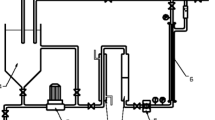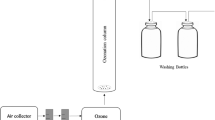Abstract
The present study aimed to investigate bis(2-ethylhexyl) phthalate (DEHP) inhibition in the flocculent and granular sludge sequencing batch reactors (GSBRs) used for the treatment of landfill leachate. Three columns of laboratory-scale sequencing batch reactors were utilized to evaluate the inhibition of the suspended flocs and aerobic granular sludge. The inhibitory concentrations of DEHP were detected as the purpose of the specific oxygen uptake rate, soluble chemical oxygen demand (SCOD), and DEHP removal function. In addition, glucose was used as the main biogenic substrate to dilute landfill leachate at 20% ratios. The GSBRs reveald a high performance in the SCOD and DEHP removal at the concentrations of up to 200 µg/L though the process ceased at 200 and 400 µg of DEHP/L in the suspended flocs sequencing batch reactors (FSBRs). At different dosing concentrations of DEHP in the reactor, short and suitable time led to the gradual accumulation of inhibitory compounds. At the inhibitory concentrations, only limited degradation of DEHP occurred. Although the assimilatory removal of DEHP was low at the normal efficiency of the FSBR, it reached significant values in the GSBRs.









Similar content being viewed by others
Abbreviations
- DEHP:
-
Bis(2-ethylhexyl) phthalate
- GSBR:
-
Granular sludge sequenting batch reactor
- FSBR:
-
Flocculent sludge sequenting batch reactor
- SBRs:
-
Sequencing batch reactors
- SCOD:
-
Soluble chemical oxygen demand
- EDCs:
-
Endocrine-disrupting compounds
- OUR:
-
Oxygen uptake rate
- SOUR:
-
Specific oxygen uptake rate
- H/D:
-
Height-to-diameter ratio
- DO:
-
Dissolved oxygen
- PLC:
-
Programmable logic controller
- OLR:
-
Organic loading rate
- UV:
-
Ultraviolet
- TSS:
-
Total suspended solids
- VSS:
-
Volatile suspended solids
- SVI:
-
Sludge volume index
- MLVSS:
-
Mixed liquor volatile suspended solid
- TOC:
-
Total organic carbon
References
Bashir MJ, Aziz HA, Amr SSA, Sap S, Ng CA, Lim JW (2015) The competency of various applied strategies in treating tropical municipal landfill leachate. Desalination Water Treat 54(9):2382–2395. https://doi.org/10.1080/19443994.2014.901189
Lam SS, Yek PNY, Ok YS, Chong CC, Liew RK, Tsang DC et al (2020) Engineering pyrolysis biochar via single-step microwave steam activation for hazardous landfill leachate treatment. J Hazard Mater 390:121649. https://doi.org/10.1016/j.jhazmat.2019.121649
Venkatesh Reddy C, Shekhar Rao D, Kalamdhad AS (2020) Statistical modelling and assessment of landfill leachate emission from fresh municipal solid waste: a laboratory-scale anaerobic landfill simulation reactor study. Waste Manag Res 38(10):1161–1175. https://doi.org/10.1177/0734242X20954280
Prasanna VL, Mamane H, Vadivel VK, Avisar D (2020) Ethanol-activated granular aerogel as efficient adsorbent for persistent organic pollutants from real leachate and hospital wastewater. J Hazard Mater 384:121396. https://doi.org/10.1016/j.jhazmat.2019.121396
Destro GE, Junior SSB, Tadayozzi YS, Almeida AA, Chaves AR, Forti JC (2020) Characterization of leachate produced by a landfill and its influence on a sewage treatment plant. Environ Qual Manag. https://doi.org/10.1002/tqem.21699
Ibor OR, Andem AB, Eni G, Arong GA, Adeougn AO, Arukwe A (2020) Contaminant levels and endocrine disruptive effects in Clarias gariepinus exposed to simulated leachate from a solid waste dumpsite in Calabar. Nigeria Aquat Toxicol 219:105375. https://doi.org/10.1016/j.aquatox.2019.105375
Di Bellaa G, Torregrossa M (2014) Aerobic granular sludge for leachate treatment. Chem Eng 38:493–498. https://doi.org/10.3303/CET1438083
Swan SH (2008) Environmental phthalate exposure in relation to reproductive outcomes and other health endpoints in humans. Environ research 108(2):177–184. https://doi.org/10.1016/j.envres.2008.08.007
Liang D-W, Zhang T, Fang HH, He J (2008) Phthalates biodegradation in the environment. Appl Microbiol Biotechnol 80(2):183. https://doi.org/10.1007/s00253-008-1548-5
Li H, Yu S, Liu F, Xie C, Li L (2007) Synthesis of dioctyl phthalate using acid functionalized ionic liquid as catalyst. Catal Commun 8(11):1759–1762. https://doi.org/10.1016/j.catcom.2007.01.029
Koch HM, Preuss R, Angerer JD (2006) Di (2-ethylhexyl) phthalate (DEHP): human metabolism and internal exposure–an update and latest results 1. Int J Androl 29(1):155–165. https://doi.org/10.1111/j.1365-2605.2005.00607.x
Sampson J, De Korte D (2011) DEHP-plasticised PVC: relevance to blood services. Transfus Med Rev 21(2):73–83. https://doi.org/10.1111/j.1365-3148.2010.01056.x
Askarian M, Heidarpoor P, Assadian O (2010) A total quality management approach to healthcare waste management in Namazi Hospital. Iran J Waste manag 30(11):2321–2326. https://doi.org/10.1016/j.wasman.2010.06.020
Meeker JD, Sathyanarayana S, Swan SH (2009) Phthalates and other additives in plastics: human exposure and associated health outcomes. Philos Trans R Soc Lond B Biol Sci 364(1526):2097–2113. https://doi.org/10.1098/rstb.2008.0268
Jonsson S, Ejlertsson J, Svensson BH (2003) Behaviour of mono-and diesters of o-phthalic acid in leachates released during digestion of municipal solid waste under landfill conditions. Adv Environ Res 7(2):429–440. https://doi.org/10.1016/S1093-0191(02)00015-1
Wilk BK, Fudala-Ksiazek S, Szopińska M, Luczkiewicz A (2019) Landfill leachates and wastewater of maritime origin as possible sources of endocrine disruptors in municipal wastewater. ESPR 26(25):25690–25701. https://doi.org/10.1007/s11356-019-05566-4
He P-J, Zheng Z, Zhang H, Shao L-M, Tang Q-Y (2009) PAEs and BPA removal in landfill leachate with Fenton process and its relationship with leachate DOM composition. Sci Total Environ 407(17):4928–4933. https://doi.org/10.1016/j.scitotenv.2009.05.036
Wang Q, Jiang L, Fang C, Mao H, Zhuang H (2020) Transformation of phthalic acid diesters in an anaerobic/anoxic/oxic leachate treatment process. Chin J Chem Eng 28(1):249–253. https://doi.org/10.1016/j.cjche.2019.07.005
Boonnorat J, Chiemchaisri C, Chiemchaisri W, Yamamoto K (2016) Kinetics of phenolic and phthalic acid esters biodegradation in membrane bioreactor (MBR) treating municipal landfill leachate. Chemosphere 150:639–649. https://doi.org/10.1016/j.chemosphere.2016.02.050
Prasad B, Suresh S (2015) Biodegradation of dimethyl phthalate ester using free cells, entrapped cells of Variovorax sp. BS1 and cell free enzyme extracts: a comparative study. Int Biodeterior Biodegradation 97:179–187. https://doi.org/10.1016/j.ibiod.2014.11.004
Boonnorat J, Techkarnjanaruk S, Honda R, Prachanurak P (2016) Effects of hydraulic retention time and carbon to nitrogen ratio on micro-pollutant biodegradation in membrane bioreactor for leachate treatment. Bioresour Technol 219:53–63. https://doi.org/10.1016/j.biortech.2016.07.094
Zhang K, Luo H, Zhu Z, Chen W, Chen J, Mo Y (2018) Performance and microbial community structure of bioaugmentation in a sequencing batch reactor treating bis (2-ethylhexyl) phthalate wastewater at low temperature. J Environ Eng 144(9):04018085. https://doi.org/10.1061/(ASCE)EE.1943-7870.0001437
Henriques ID, Kelly RT, Dauphinais JL, Love NG (2007) Activated sludge inhibition by chemical stressors—a comprehensive study. J WER 79(9):940–951. https://doi.org/10.2175/106143007X156709
Ofman P, Struk-Sokołowska J, Skoczko I, Wiater J (2020) Alternated biodegradation of naphthalene (NAP), acenaphthylene (ACY) and acenaphthene (ACE) in an aerobic granular sludge reactor (GSBR). J Hazard Mater 383:121184. https://doi.org/10.1016/j.jhazmat.2019.121184
Roodbari A, Nodehi RN, Mahvi A, Nasseri S, Dehghani M, Alimohammadi M (2012) Use of a sonocatalytic process to improve the biodegradability of landfill leachate. Braz J Chem Eng 29(2):221–230. https://doi.org/10.1590/S0104-66322012000200003
Wang K, Li L, Tan F, Wu D (2018) Treatment of landfill leachate using activated sludge technology: A review. Archaea 2018:1039453. https://doi.org/10.1155/2018/1039453
Yong ZJ, Bashir MJ, Ng CA, Sethupathi S, Lim J-W (2018) A sequential treatment of intermediate tropical landfill leachate using a sequencing batch reactor (SBR) and coagulation. J environ manag 205:244–252. https://doi.org/10.1016/j.jenvman.2017.09.068
Ren Y, Ferraz F, Kang AJ, Yuan Q (2017) Treatment of old landfill leachate with high ammonium content using aerobic granular sludge. J Biol Eng 11(1):42. https://doi.org/10.1186/s13036-017-0085-0
Ren Y, Ferraz F, Lashkarizadeh M, Yuan Q (2017) Comparing young landfill leachate treatment efficiency and process stability using aerobic granular sludge and suspended growth activated sludge. J Water Process Eng 17:161–167. https://doi.org/10.1016/j.jwpe.2017.04.006
Vahabian M, Hassanzadeh Y, Marofi S (2019) Assessment of landfill leachate in semi-arid climate and its impact on the groundwater quality case study: Hamedan. Iran Environ Monit Assess 191(2):109. https://doi.org/10.1007/s10661-019-7215-8
Chaudhary A, Waske SA, Yadav S, Chandrashekhar T, Singh V (2010) Validated reverse phase HPLC method for the determination of DEHP content in reconstituting diluents and in reconstituted solutions of imipenem and cilastatin for injection. E-J Chem 7(2):501–513. https://doi.org/10.1080/10826070600983393
Association APH, Association AWW, Federation WPC, Federation WE (1915) Standard methods for the examination of water and wastewater: American Public Health Association
Rafiee M, Mesdaghinia A, Ghahremani MH, Nasseri S, Nabizadeh R (2012) 4-chlorophenol inhibition on flocculent and granular sludge sequencing batch reactors treating synthetic industrial wastewater. Desalination Water Treat 49(1–3):307–316. https://doi.org/10.1080/19443994.2012.719352
Moy BP, Tay JH, Toh SK, Liu Y, Tay SL (2002) High organic loading influences the physical characteristics of aerobic sludge granules. Lett Appl Microbiol 34(6):407–412. https://doi.org/10.1046/j.1472-765X.2002.01108.x
Tay J-H, Pan S, He Y, Tay STL (2004) Effect of organic loading rate on aerobic granulation. II: Characteristics of aerobic granules. J Environ Eng 130(10):1102–1109. https://doi.org/10.1061/(ASCE)0733-9372(2004)130:10(1102)
Quan C, Liu Q, Tian W, Kikuchi J, Fan S (2005) Biodegradation of an endocrine-disrupting chemical, di-2-ethylhexyl phthalate, by Bacillus subtilis No. 66. Appl Microbiol Biotechnol 66(6):702–710. https://doi.org/10.1007/s00253-004-1683-6
Quoc BN, Wei S, Armenta M, Bucher R, Sukapanpotharam P, Stahl DA et al (2021) Aerobic granular sludge: impact of size distribution on nitrification capacity. Water Res 188:116445. https://doi.org/10.1016/j.watres.2020.116445
Zheng Y-M, Yu H-Q, Liu S-J, Liu X-Z (2006) Formation and instability of aerobic granules under high organic loading conditions. Chemosphere 63(10):1791–1800. https://doi.org/10.1016/j.chemosphere.2005.08.055
Mohan TVK, Renu K, Nancharaiah YV, Sai PMS, Venugopalan VP (2016) Nitrate removal from high strength nitrate-bearing wastes in granular sludge sequencing batch reactors. J Biosci Bioeng 121(2):191–195. https://doi.org/10.1016/j.jbiosc.2015.05.015
Wang S, Ma X, Wang Y, Du G, Tay J-H, Li J (2019) Piggery wastewater treatment by aerobic granular sludge: granulation process and antibiotics and antibiotic-resistant bacteria removal and transport. Bioresour Technol 273:350–357. https://doi.org/10.1016/j.biortech.2018.11.023
Ren Y, Ferraz F, Yuan Q (2018) Biological leachate treatment using anaerobic/aerobic process: suspended growth-activated sludge versus aerobic granular sludge. Int J Sci Environ Technol 15(11):2295–2302. https://doi.org/10.1007/s13762-017-1633-3
Ren Y, Ferraz F, Kang AJ, Yuan Q (2017) Treatment of old landfill leachate with high ammonium content using aerobic granular sludge. J Biol Eng 11(1):1–8. https://doi.org/10.1186/s13036-017-0085-0
Wei Y, Ji M, Li R, Qin F (2012) Organic and nitrogen removal from landfill leachate in aerobic granular sludge sequencing batch reactors. Waste Manag 32(3):448–455. https://doi.org/10.1016/j.wasman.2011.10.008
Aziz SQ, Aziz HA, Yusoff MS (2011) Bashir MJ (2011) Landfill leachate treatment using powdered activated carbon augmented sequencing batch reactor (SBR) process: Optimization by response surface methodology. J Hazard Mater 189(1–2):404–413. https://doi.org/10.1016/j.jhazmat.2011.02.052
González-Márquez A, Loera-Corral O, Santacruz-Juárez E, Tlécuitl-Beristain S, García-Dávila J, Viniegra-González G et al (2019) Biodegradation patterns of the endocrine disrupting pollutant di (2-ethyl hexyl) phthalate by Fusarium culmorum. Ecotoxicol Environ Saf 170:293–299. https://doi.org/10.1016/j.ecoenv.2018.11.140
Gartshore J, Cooper DG, Nicell JA (2003) Biodegradation of plasticizers by Rhodotorula rubra. Environ Toxicol Chem 22(6):1244–1251. https://doi.org/10.1002/etc.5620220609
Ortiz I, Revah S (2009) Modelling phenanthrene biodegradation and mineralisation in polluted soil using toluene as gaseous cosubstrate. J Chem Technol Biotechnol 84(2):246–253. https://doi.org/10.1002/jctb.2031
Fang HH, Liang D, Zhang T (2007) Aerobic degradation of diethyl phthalate by Sphingomonas sp. Bioresour Technol 98(3):717–720. https://doi.org/10.1016/j.biortech.2006.02.010
Ruzicka K, Gabriel O, Bletterie U, Winkler S, Zessner M (2009) Cause and effect relationship between foam formation and treated wastewater effluents in a transboundary river. Phys Chem Earth 34(8–9):565–573. https://doi.org/10.1016/j.pce.2009.01.002
Funding
The Vice Chancellery for Research at Hamadan University of Medical Sciences (PhD dissertation No. 99010536) and Iran National Science Foundation (INSF) provided financial support of this research project (No. 98021644).
Author information
Authors and Affiliations
Corresponding author
Ethics declarations
Conflict of interest
The authors declare that they have no known competing financial interests or personal relationships that could have appeared to influence the work reported in this paper.
Additional information
Publisher's note
Springer Nature remains neutral with regard to jurisdictional claims in published maps and institutional affiliations.
Rights and permissions
About this article
Cite this article
Seid-Mohammadi, A., Asgari, G., Rafiee, M. et al. Bis(2-ethylhexyl) phthalate inhibition on aerobic flocculent and granular sludge in the treatment of landfill leachate: a comparative study. Biomass Conv. Bioref. 13, 10421–10433 (2023). https://doi.org/10.1007/s13399-021-01934-8
Received:
Revised:
Accepted:
Published:
Issue Date:
DOI: https://doi.org/10.1007/s13399-021-01934-8




